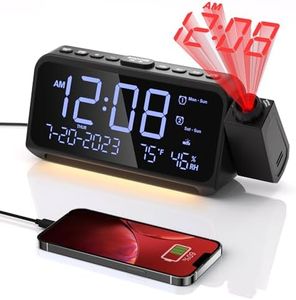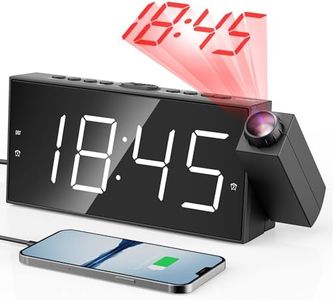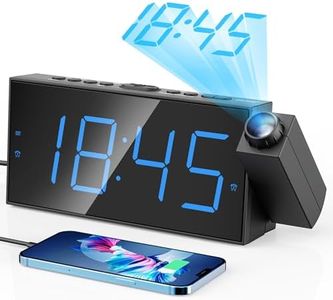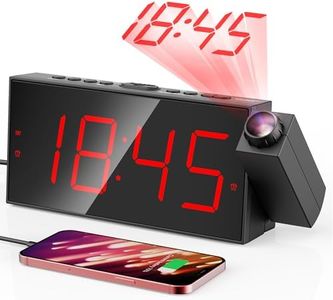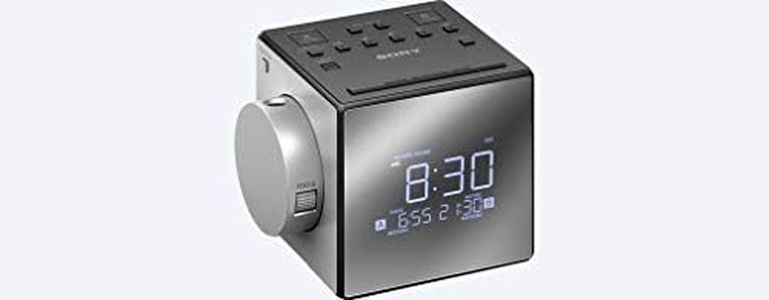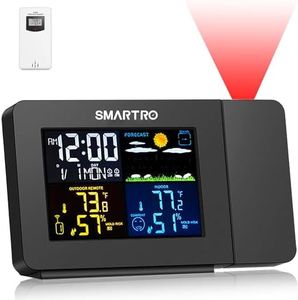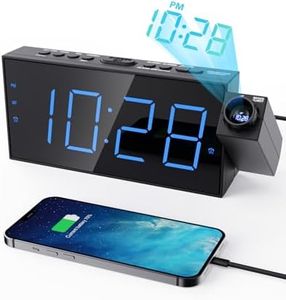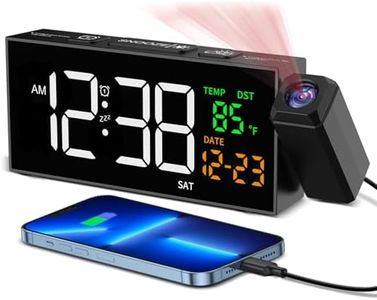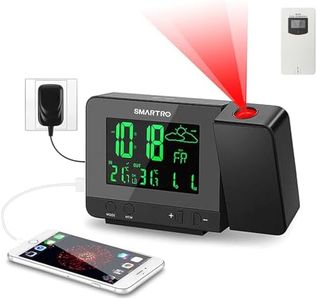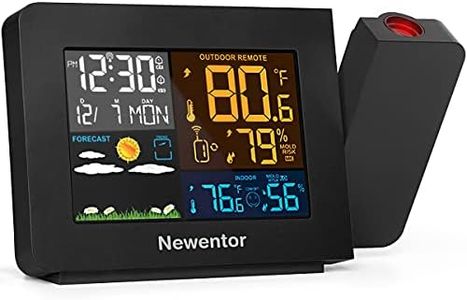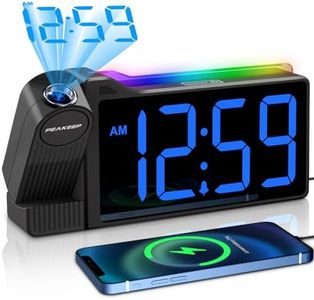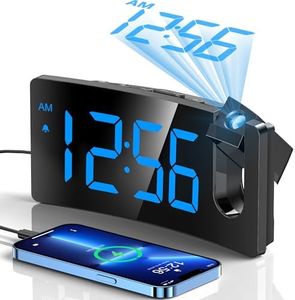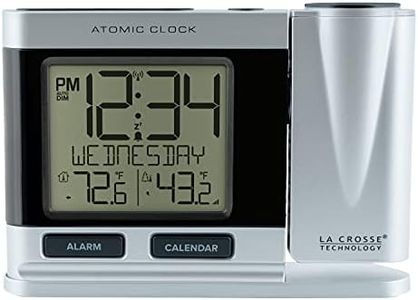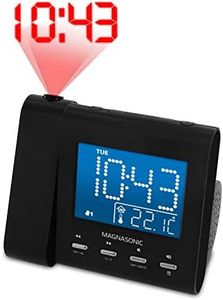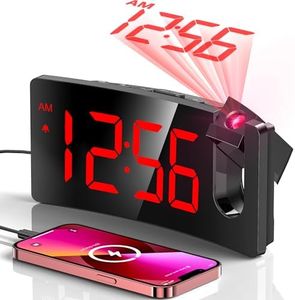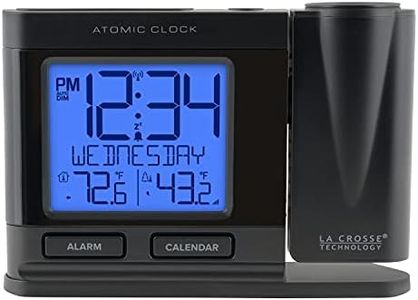10 Best Projection Clocks 2025 in the United States
Our technology thoroughly searches through the online shopping world, reviewing hundreds of sites. We then process and analyze this information, updating in real-time to bring you the latest top-rated products. This way, you always get the best and most current options available.

Our Top Picks
Winner
Mesqool Digital Projector Alarm Clocks for Kids Bedroom,Plug-in Clock with 180° Projection on Ceiling Wall,Dual Alarms for Heavy Sleepers,Battery Backup,USB Charging Port,Easy-to-Set,Dimmer,Snooze
Most important from
27145 reviews
The Mesqool Digital Projection Alarm Clock offers a versatile and clear time display with its 180° rotatable projection that can be aimed at the ceiling or wall. Its projection distance ranges from about 1.6 to 9.8 feet, allowing you to choose one of three projection sizes to suit your room. The focus ring lets you sharpen the projected image, which is a useful touch for clarity. The 7-inch LED display is large and easy to read, even from across the room, and comes with five dimming levels ensuring the brightness can be set low enough to avoid disturbing sleep. This is especially good for kids and light sleepers.
Dual alarms with snooze and adjustable volume levels make it practical for heavy sleepers and those with different wake-up times, such as couples or families. The snooze feature is standard but handy for extra sleep. The clock supports both 12- and 24-hour formats and includes a daylight saving time adjustment, adding flexibility.
Power-wise, the clock requires constant AC power to function fully but includes a battery backup feature (2 AAA batteries, not included) that saves settings during outages, so you don't have to reset the clock or alarms. A nice bonus is the built-in USB charging port, letting you charge phones or tablets overnight. It must be plugged in to work, which means no fully wireless option. It also relies on user-supplied batteries for backup, which could be inconvenient for some. The plastic build is lightweight but may feel less durable compared to more premium materials. While the projection is adjustable, the red digits might be less sharp in very bright rooms. This clock fits well for families wanting a kid-friendly, easy-to-read projection alarm with useful extras like USB charging and dual alarms, but it’s less suited for those wanting a battery-only or completely portable device.
Most important from
27145 reviews
Digital Projection Alarm Clocks for Bedrooms - Large LED Display, 180° Rotatable Projector, 5-Level Dimmer,USB Charger,Battery Backup,Loud Dual Alarms for Kids Elderly,Heavy Sleepers,Snooze,12/24H,DST
Most important from
27145 reviews
The Digital Projection Alarm Clock by Mesqool offers several features tailored for convenience and usability. The 180° rotatable projector enables you to project time onto your wall or ceiling, with a clear display even from 1.6 to 9.8 feet away. Users can adjust the projector's focus and orientation to ensure the time is always readable. The clock’s display and projection brightness are adjustable across 5 levels, which is particularly useful for those sensitive to light at night. The 7-inch large LED display is easy to read, even from a distance, making it suitable for the elderly and individuals with vision impairments.
This clock is equipped with dual alarms, catering to couples with different schedules or as a backup for heavy sleepers. The alarms have adjustable volumes, and the large snooze button allows for extra sleep without hassle. The clock also supports 12/24-hour time formats and has a Daylight Saving Time (DST) feature. Power is primarily sourced through an AC connection, but it includes a battery backup (2 AAA batteries) to retain settings during power outages. Additionally, a USB charging port is available to charge devices overnight.
One potential drawback is the reliance on a continuous power source for full functionality, meaning if not plugged in, features other than time and alarm memory may not work. The plastic build, while lightweight, might not appeal to those looking for more robust materials. Despite these minor issues, this projection clock stands out for its practical features and ease of use, making it ideal for families, heavy sleepers, and the elderly looking for an intuitive and convenient alarm clock.
Most important from
27145 reviews
Mesqool Projection Alarm Clock, Digital Clock with 180° Rotatable Projector, 5-Level Brightness Dimmer, Clear LED Display, USB Charger, Progressive Volume, 9mins Snooze,12/24H, for Bedroom
Most important from
27146 reviews
The Mesqool Projection Alarm Clock stands out with its 180° adjustable projector, allowing users to easily view the time on walls or ceilings from a distance of 1.6 to 9.8 feet. This feature is particularly beneficial for those who want to check the time without getting out of bed. The ultra-clear LED display is another plus, boasting a large size that makes it easy to read, even for those with vision challenges. Users can also adjust the brightness with five levels, catering to different sensitivities to light at night.
This clock includes a dual alarm feature, perfect for couples or heavy sleepers, as well as a convenient snooze option that offers an extra 9 minutes of sleep. The volume can be adjusted from soft to loud, making it accommodating for various preferences. Additionally, the inclusion of a USB charging port is a thoughtful touch, allowing users to charge their devices overnight.
However, the clock requires a continuous power source, which means it won’t function during a power outage unless backup batteries are installed. The batteries (not included) only maintain time settings and won’t power the clock entirely. Some users might find the setup process slightly tricky initially, although it is designed to be user-friendly. In terms of design, while it has a retro look that some may appreciate, it might not blend seamlessly with all modern decor styles. The clock is suitable for a variety of settings, including bedrooms and home offices, making it versatile for different lifestyles. The Mesqool Projection Alarm Clock combines convenience with practicality, making it a solid choice for users seeking an easy-to-read, multi-functional clock.
Most important from
27146 reviews
Buying Guide for the Best Projection Clocks
Projection clocks are a great addition to any bedroom or living space, offering the convenience of projecting the time onto a wall or ceiling. This can be particularly useful for those who want to check the time without having to turn over or sit up. When choosing a projection clock, it's important to consider several key specifications to ensure you get the best fit for your needs. Here are the main specs to look out for and how to navigate them.FAQ
Most Popular Categories Right Now
